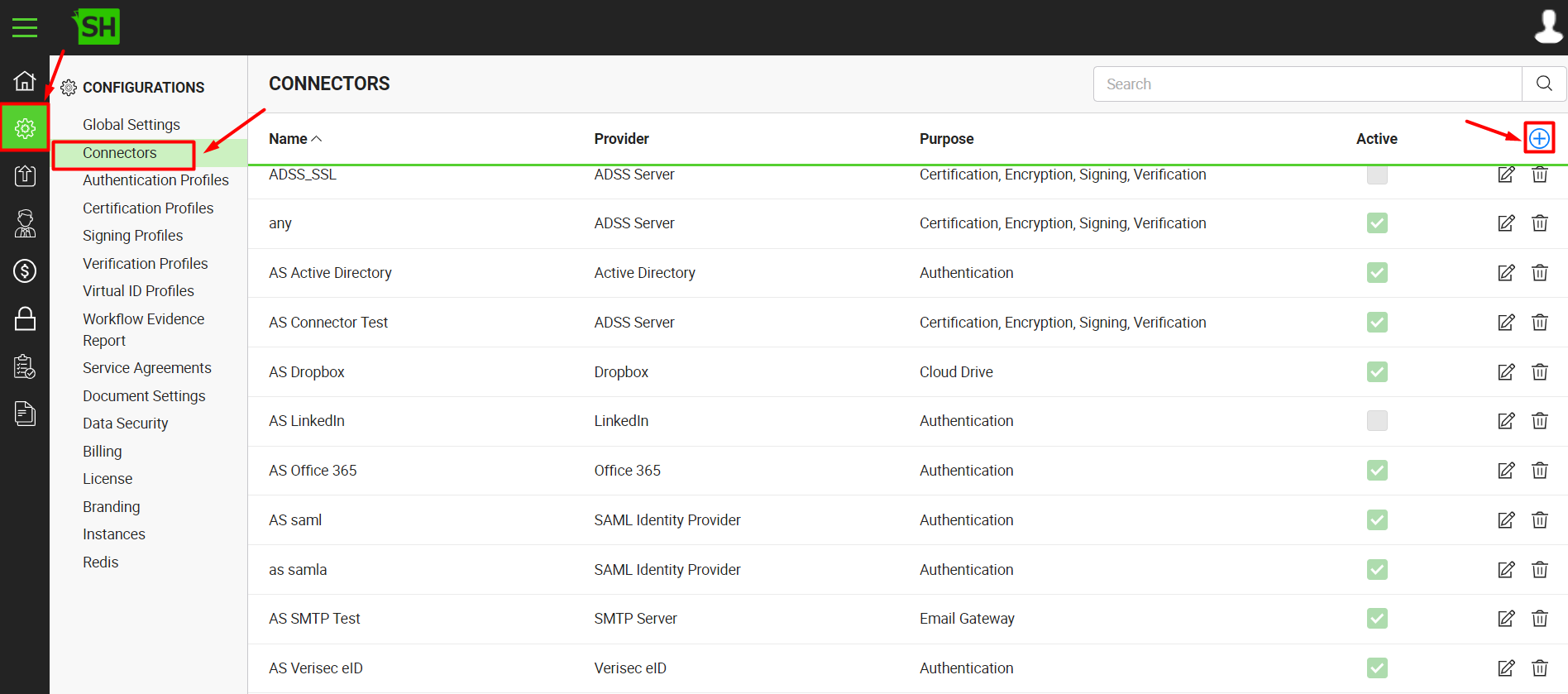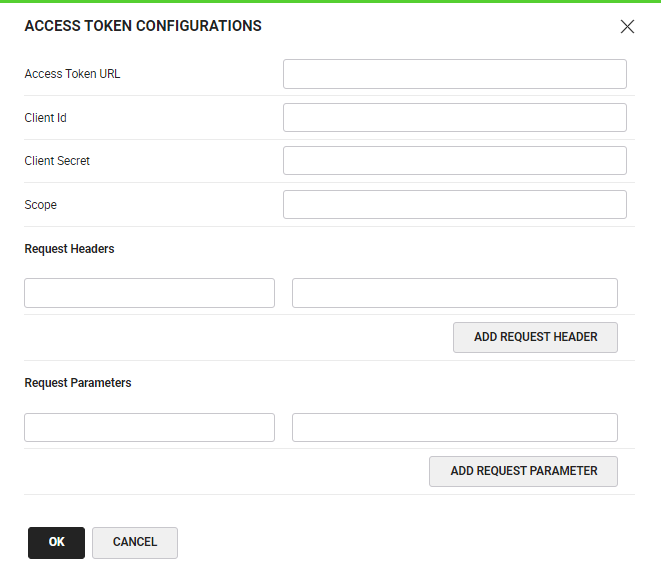Create an SMS Connector
The SMS connector allows SigningHub to connect with any SMS Gateway to provide SMS gateway services to SigningHub Desktop Web. It is a generic connector that can accept:
- URL of the SMS Gateway to send an HTTP request
- HTTP method, i.e. POST or GET
- Dynamic key value pair of attributes that are sent in the HTTP request
By using this connector, SigningHub can seamlessly connect with any SMS gateway(s) through the provided parameters to send off OTP messages to the recipients.
Create an SMS connector
- Click the "Configurations" option from the left menu.
- Click the "Connectors" option.
The "Connectors" screen will appear. - Click
 from the grid header.
from the grid header.
- A dialog will appear to add the connector details. The connector dialog is comprised of two screens, i.e. Basic Information and Details. Specify the basic information and click the "Next" button to provide the respective connector details.
- Click the "Finish" button. A new connector will be saved and displayed in the list. See the below table for fields description.
The following table describes the fields on the "Basic Information" section of this dialog.
|
Basic Information |
|
|
Fields |
Description |
|
Name |
Specify a unique name for this connector, i.e. My SMS. This connector will be used in the configuration of Global Settings and service plans. |
|
Provider |
Select the provider for this connector, i.e. "SMS". |
|
Purpose |
This field will display the purpose of the selected provider above, i.e. the purpose of "SMS" is "SMS Gateway". |
|
Active |
Tick this check box to make this connector active. Inactive connectors cannot be configured in the Global Settings and service plans. |
The following table describes the fields on the "Details" section of this dialog.
|
Details |
|
|
Fields |
Description |
|
Logo |
Select an appropriate image in the jpeg, jpg, gif or png format for the connector's logo that will be displayed on the login screen. |
||||||||||||||||||||||
|
URL |
Specify the server URL on which system will request to send SMS. |
||||||||||||||||||||||
|
Method |
Choose a method for this SMS connector as required, i.e. GET or Post.
|
||||||||||||||||||||||
|
Request Headers |
|||||||||||||||||||||||
|
Authorization |
Choose an authorization header while sending the request, i.e.:
Clicking on the "Configurations" button will open the "Access Token Configurations" dialog, containing the following fields.
|
||||||||||||||||||||||
|
Content Type |
Choose a content type for this SMS connector, i.e.:
|
||||||||||||||||||||||
|
Add Request Header |
Click this button to add more request header fields. A pair of fields will be added, to specify the custom header that will be sent to the URL while sending the request, e.g. "X-Version: 1" is a custom header. |
||||||||||||||||||||||
|
Request Parameters |
|||||||||||||||||||||||
|
Param Number |
This parameter is filled in by the server itself while sending OTP to a client. Specify the parameter number that is being used by the SMS Gateway API. |
||||||||||||||||||||||
|
Param Message |
This parameter is filled in by the server itself while sending OTP to a client. Specify the parameter message that is being used by the SMS Gateway API. |
||||||||||||||||||||||
|
Add Request Parameter |
Click this button to add more request parameter fields. A pair of fields will be added, to specify any additional parameter which is required by the SMS gateway, but is not available in the default request parameters as provided above, e.g. Twillio requires Account SID. So you can add a field pair, and specify "Account SID" in the left field and its corresponding value in the right field.
|
||||||||||||||||||||||
|
Send Message |
Click this button to validate the provided SMS gateway configurations by sending a test SMS. A dialog will appear, specify your mobile number along with the correct country code and click the "Send" button. Based on the server reply, a toaster message of success or failure will be displayed.
|
||||||||||||||||||||||
See Also
- Create a LinkedIn Connector
- Create a Google Connector
- Create a OneDrive Connector
- Create an ADSS Server Connector
- Create a Clickatell Connector
- Create a Twilio Connector
- Create a Worldpay Connector
- Create a Stripe Connector
- Create an SMTP Server Connector
- Create an Active Directory Connector
- Create a Dropbox Connector
- Create a Salesforce Connector
- Create a SAML IdP Connector
- Create a Google Drive Connector
- Create a HubSpot Connector
- Create an Office 365 Connector
- Create an ADFS Connector
- Create a Maxmind GeoIP Connector
- Create a Firebase Connector
- Create a Freja Mobile Connector
- Create a Freja eID Connector
- Create an Azure Blob Connector
- Create an Azure Active Directory Connector
- Create a Bank ID Connector
- Create a Captcha Connector
- Create an itsme Connector
- Create a T1C Connector
- Create a File Scanning Connector
- Create a CSC Connector
- Create an OAuth2.0 Connector
- Create an OIDC Connector
- Edit a Connector
- Delete a Connector
- Search a Connector


